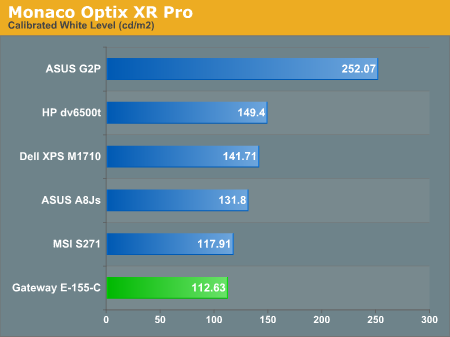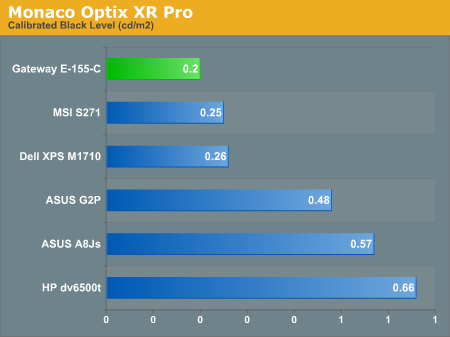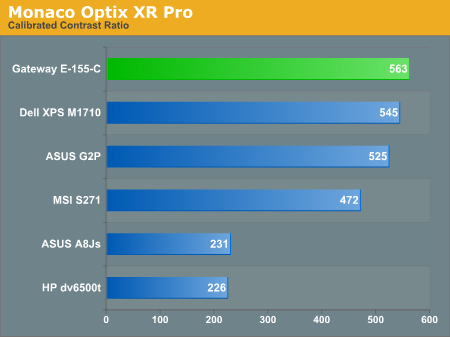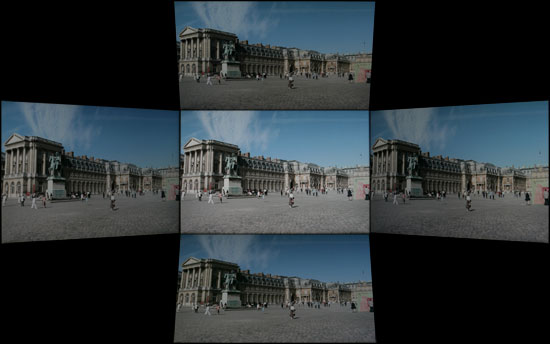Gateway E-155-C: A Lightweight Convertible
by Jarred Walton on July 4, 2007 12:05 AM EST- Posted in
- Laptops
LCD Brightness, Contrast, and Viewing Angles
In keeping with our tradition of striving to provide the most detailed hardware reviews around, we took a closer look at the LCD used in the E-155-C. Unfortunately, as is generally the case with all laptops, we cannot guarantee that the LCD panel used in our particular sample will be the same as that used in other notebooks, even if they have the same model number. Many of the larger OEMs will source LCD panels from several manufacturers, and they could potentially change panels at any time. Certain panel types are more likely to have this occur than others, and the use of a touch-sensitive screen may mean that Gateway only has one panel source for this particular model. However, they have not indicated that this is the case and so we recommend you take our display measurements with these qualifications in mind.
Using ASTRA32, a utility to that probes for various low-level details about your computer hardware, the LCD panel in our test unit is listed as a BOE 089A apparently manufactured by BOE Technology Co., Ltd. It is entirely possible for ASTRA32 to make mistakes, but short of tearing apart the notebooks we review - and potentially ruining the LCD panels - that's the best information we can provide. The manufacturing date is listed as January 2006.
Our general impressions of the LCD panel are favorable, though we have to qualify that statement somewhat. We found the viewing angles to be much better than many other laptops, but at the same time the display does not get as bright as other units we've used. It could be that the touch-sensitive aspect may be affecting the brightness levels, but more likely is that the backlight is simply not as bright as we have seen in other notebooks. Considering this is a thin and light laptop, the latter would be our guess.
For our objective tests, we'll start with a look at brightness and contrast ratios along with viewing angles. We'll conclude on the following page with an examination of the color accuracy, before and after hardware calibration. For color accuracy, we are including results using ColorEyes Display Pro in addition to Monaco Optix XR Pro. One reader pointed out that Monaco Optix XR Pro uses the older ICCv2 profile specification and it may not be as accurate as software that uses the more recent ICCv4 specification. In testing we have discovered that there are certainly differences between the two software packages when it comes to color calibration, but neither one is consistently better. We use a Monaco Optix XR Pro colorimeter (which is the same as the DTP-94) with both software packages.



Our testing confirms what we noticed with our eyes: the white level is slightly lower than that of most other laptop LCDs, maxing out at around 113 nits; black levels on the other hand are very good, coming in at 0.20 nits. The net result is a relatively high contrast ratio of 563. Subjectively, we would agree with the measurements: the overall quality of the LCD panel is very good in terms of contrast ratio and black levels, but it's simply not very bright. Some people dislike overly bright LCDs, but we're pretty happy with 200-300 nits like what you find on most desktop LCDs. (We definitely agree that models rated at 500+ nits are taking things too far, however.) Whether or not you will like the E-155-C LCD will depend a lot on how bright you like your displays to be.
Brightness levels and contrast ratios aren't the only important aspects of a display, so let's look at the viewing angles, taken at 30° from center. Images for the other laptops can be viewed at the following links:
ASUS A8Js
ASUS G2P
Dell M1710
HP dv6500t
MSI S271
The reduced brightness level isn't immediately apparent when looking at the above images, but we chalk that up to minor variations in the photography and image editing process. (We may need to go back and redo some of the other laptops to make sure that our results are consistent.) At a perfect straight-on viewing angle, even something like the ASUS A8Js might seem pretty good. In actual use, however, we find viewing angles to be extremely important on laptops, and here the Gateway E-155-C excels. The horizontal viewing angles aren't really better than any of the other results, but one look at the vertical viewing angles and you can clearly see why we're impressed. Simply put, this is one of the better laptops we've used in terms of vertical viewing angles. It's a good thing too, since tablet PCs are even more likely to be used in off-angle viewing.
In keeping with our tradition of striving to provide the most detailed hardware reviews around, we took a closer look at the LCD used in the E-155-C. Unfortunately, as is generally the case with all laptops, we cannot guarantee that the LCD panel used in our particular sample will be the same as that used in other notebooks, even if they have the same model number. Many of the larger OEMs will source LCD panels from several manufacturers, and they could potentially change panels at any time. Certain panel types are more likely to have this occur than others, and the use of a touch-sensitive screen may mean that Gateway only has one panel source for this particular model. However, they have not indicated that this is the case and so we recommend you take our display measurements with these qualifications in mind.
Using ASTRA32, a utility to that probes for various low-level details about your computer hardware, the LCD panel in our test unit is listed as a BOE 089A apparently manufactured by BOE Technology Co., Ltd. It is entirely possible for ASTRA32 to make mistakes, but short of tearing apart the notebooks we review - and potentially ruining the LCD panels - that's the best information we can provide. The manufacturing date is listed as January 2006.
Our general impressions of the LCD panel are favorable, though we have to qualify that statement somewhat. We found the viewing angles to be much better than many other laptops, but at the same time the display does not get as bright as other units we've used. It could be that the touch-sensitive aspect may be affecting the brightness levels, but more likely is that the backlight is simply not as bright as we have seen in other notebooks. Considering this is a thin and light laptop, the latter would be our guess.
For our objective tests, we'll start with a look at brightness and contrast ratios along with viewing angles. We'll conclude on the following page with an examination of the color accuracy, before and after hardware calibration. For color accuracy, we are including results using ColorEyes Display Pro in addition to Monaco Optix XR Pro. One reader pointed out that Monaco Optix XR Pro uses the older ICCv2 profile specification and it may not be as accurate as software that uses the more recent ICCv4 specification. In testing we have discovered that there are certainly differences between the two software packages when it comes to color calibration, but neither one is consistently better. We use a Monaco Optix XR Pro colorimeter (which is the same as the DTP-94) with both software packages.



Our testing confirms what we noticed with our eyes: the white level is slightly lower than that of most other laptop LCDs, maxing out at around 113 nits; black levels on the other hand are very good, coming in at 0.20 nits. The net result is a relatively high contrast ratio of 563. Subjectively, we would agree with the measurements: the overall quality of the LCD panel is very good in terms of contrast ratio and black levels, but it's simply not very bright. Some people dislike overly bright LCDs, but we're pretty happy with 200-300 nits like what you find on most desktop LCDs. (We definitely agree that models rated at 500+ nits are taking things too far, however.) Whether or not you will like the E-155-C LCD will depend a lot on how bright you like your displays to be.
Brightness levels and contrast ratios aren't the only important aspects of a display, so let's look at the viewing angles, taken at 30° from center. Images for the other laptops can be viewed at the following links:
ASUS A8Js
ASUS G2P
Dell M1710
HP dv6500t
MSI S271
 |
The reduced brightness level isn't immediately apparent when looking at the above images, but we chalk that up to minor variations in the photography and image editing process. (We may need to go back and redo some of the other laptops to make sure that our results are consistent.) At a perfect straight-on viewing angle, even something like the ASUS A8Js might seem pretty good. In actual use, however, we find viewing angles to be extremely important on laptops, and here the Gateway E-155-C excels. The horizontal viewing angles aren't really better than any of the other results, but one look at the vertical viewing angles and you can clearly see why we're impressed. Simply put, this is one of the better laptops we've used in terms of vertical viewing angles. It's a good thing too, since tablet PCs are even more likely to be used in off-angle viewing.










25 Comments
View All Comments
elom - Wednesday, April 2, 2008 - link
This deal has been horrible for the companies that had existing warrenties with Gateway. MPC has still yet to get there act together and it is now April. My company has had 28 of these machines down since the begining of the year and only half have been fixed. I have NBD on-site service and I am not seeing anywhere close to that. I am moving to another PC manufacturer ASAP.tacoburrito - Wednesday, July 4, 2007 - link
With the 6 cell battery, this thing will weight over 5 lbs. Not really an ultra-portable in the classical sense, is it? But it seems this is what we have to put up with if one wants the Tablet features. Lenovo, Toshiba, and HP already have sub-3lbs notebooks in their catalouge running similar specs to the Gateway. Can you review those instead, if you want to do an ultra-portable review?JarredWalton - Wednesday, July 4, 2007 - link
As always, we review what we get sent. Needless to say, I'm not about to go out and spend $2000 on a notebook just to provide free press for a company. I've tried to get in touch with Lenovo, without much success. I'm working to get some stuff from Toshiba and HP that falls in the ultraportable range, so we'll see.Honestly, I'm not quite sure why the notebook is so heavy relative to others. The case does feel pretty durable, however, so that's probably a large part of the weight question. The display doesn't really feel much heavier than a normal laptop LCD - certainly not more than a few ounces. Anyway, lightweight and flimsy may not be the right way to go either - I'd probably take the extra pound if it means the display hinges and other parts don't break after a year or two.
bldckstark - Friday, July 6, 2007 - link
I'm disappointed to see that Lenovo hasn't responded to your requests. I would really like to see their V and X series ultraportables up against the competition.I bought my wife the Lenovo V series laptop that is almost an exact twin of the Gateway reviewed here, with the exception of the convertible screen. It is quicker than my desktop 3800+, weighs 4.4lbs with the 6 cell battery, and gets 255 mins runtime on, all for $1,250. It really puts the Gateway to shame. At least this time I didn't buy an expensive piece of electronics just to go online a month later to see a review of a cheaper, faster, better device that makes me want to throw up.
What I can't compare at home though is the LCD screen quality versus the Gateway. I would like to see if the Lenovo screens are better, worse, same. Especially on the V series versus the X/T series.
This makes me really want to see the Lenovo T60 reviewed to see how much dust the Gateway would be eating.
jonp - Friday, July 20, 2007 - link
I'd vote to add a Lenovo T61, p/n 7662 with the T7500 CPU, 2GB RAM, 7200rpm hard drive, XP Pro to a future review.Athlex - Wednesday, July 4, 2007 - link
Any chance of getting a photo of the keyboard and touchpad/trackpoint?Baffling that laptop manufacturers are putting "docking" ports on the sides of notebooks instead of the bottom. HPQ seems to be doing the same thing on their consumer stuff.
JarredWalton - Wednesday, July 4, 2007 - link
Sorry about that - I actually had the image on our server but forgot to update the first page before the article went live.I'm also a bit baffled about the docking port on the side... but then I don't see much reason for docking stations these days. All I really need is mouse, keyboard, and display - if I want more than that from a laptop, I'd probably get a nicer laptop rather than worrying about spending the money for a docking station.
strikeback03 - Thursday, July 5, 2007 - link
If you connect keyboard/mouse/monitor every day (or multiple times a day) it is probably convenient to only have to make one connection instead of 3. also, some docking stations offer ports the laptop does not - for example, most (if not all) thinkpad docking stations have DVI ports even though the laptop itself does not.One reason this might be heavier than other tablets is the included optical drive - lots of the ~3lb ones ditch that, and the whole case can shrink as a result.
JarredWalton - Thursday, July 5, 2007 - link
Gateway does list the laptop as weighing .3 lbs less with a "weight saver" - I'm guessing a plastic piece that fills the ODD slot. I do have to say that ditching the DVD - except you would have an external unit - isn't a good move IMO. That's just marketing trying to cut weight at all costs. I suppose I could live without a DVD in a pinch, but I really wouldn't want to.People that will spend $200+ to save themselves two connections are a bit out there, I'd say. The DVI port could be useful, but plenty of laptops have those anyway. Heck, ditch the docking port connector and give us DVI and we'd be set. Heh.
Verdant - Wednesday, July 4, 2007 - link
a lot of people seem to refer to the screens as "touch screens" i thought they used some sort of circuit that involved the stylus. Do tablets have a "touch" or "digitizer stylus" screen? Or do both exist?Personally i would prefer non-touch screen as writing on those can be difficult with my left-handedness.